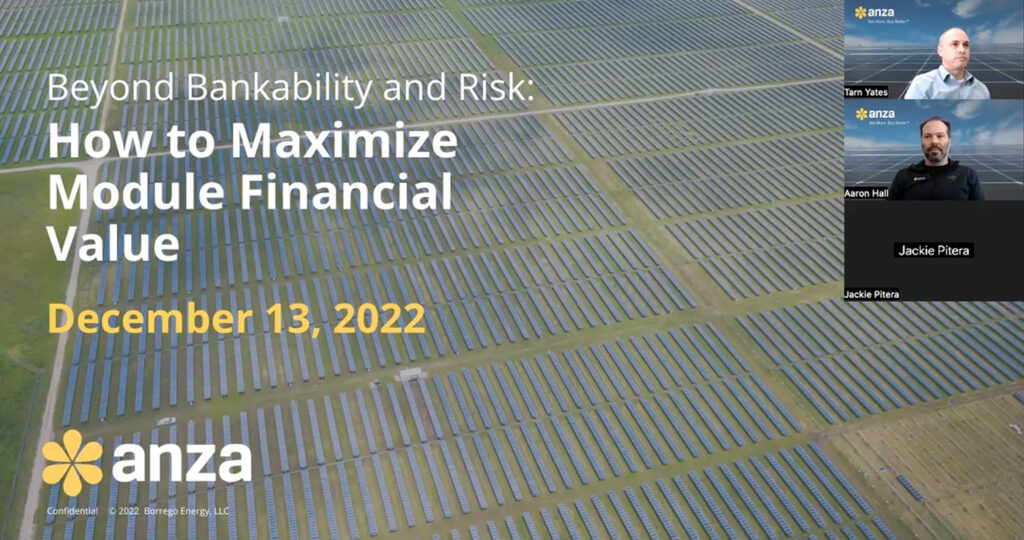With the volatile and constrained solar supply chain of the past few years, it’s become a challenge for developers, IPPs and EPCs to find the solar modules they want, when they want them. Not every organization has the bandwidth, resources and personnel to conduct a thorough procurement process, taking into account all the available module options and project variables that might impact the ultimate choice.
It’s important to conduct a long-term financial analysis to determine which module will end up maximizing the revenues of the asset over its lifetime — otherwise money could be left on the table.
In our recent webinar titled “Beyond Bankability and Risk: How to Maximize Module Financial Value,” we discussed some of the most common levers and calculations that can be used for selecting the highest-value modules for a project. We used a pair of case studies — one a 49 MW utility-scale single axis tracker, the other a 5 MW distributed generation fixed-tilt ground-mount — to examine the impact of those optimization levers. Using our Anza platform analytics, we show that module choice impacts not only module cost, but also balance of systems (BOS) costs, revenue and net present value.

Optimization Levers
Module installation labor, foundation materials and labor, racking type and labor, and DC source circuit materials (wire management, connectors, etc.) and labor all play a role in the optimization calculation. For these BOS calculations, we factor in location of the project, weather (snow load, wind, etc.), racking type (time it takes to install a module differs), wage rates and other data points, drawing from our vast location and component databases.
Modules can also affect revenue, caused by deltas in energy production (due to varying low-light or high-temperature performance among competing modules, for example), degradation rates, or shading losses. One lever we are looking at incorporating in future iterations of the Anza platform is the value of energy or power purchase agreement impact, since one could see the module choices for best NPV change depending on if that value goes higher or lower.
Once all those levers are pulled, what results is counterintuitive to many procurement pros: solving for the lowest cost module doesn’t always maximize financial returns. That’s why it’s important to use net present value (NPV) or internal rate of return (IRR) to get the largest return possible out of the project.
A Tale of Two Case Studies: Lowest Cost Modules Don’t Always Maximize NPV Every Time
In our first case study, the 49 MW single axis tracker, we ran the numbers for a pair of 540-watt and 650-watt modules. The 540 was the lower cost choice by more than four cents per watt, but the 650 had several BOS cost advantages. With the bigger module, fewer were needed (15,000 fewer in this case), resulting in less foundation work and a smaller number of trackers needed than would have been the case using the 540s, thus lowering those foundation and racking costs to the tune of two cents per watt installed.
The 650s also had a cost advantage on the DC wiring lever, since the lower voltage of the larger modules allowed for more modules per string. The calculation revealed that 1100 fewer strings—and more than 300,000 feet less wire— would be needed, resulting in a savings of another penny per watt compared to the numbers for the 540.
When we looked at the module performance differences, the larger 650 came out on top in almost every category: loss due to irradiance level, light-induced degradation (LID), temperature and incident angle modifier (IAM), resulting in a 2% delta in yield. The two modules had 0.5% annual degradation guarantees, so that metric had no influence on the NPV outcome.
After we pulled all the optimization levers for this project, the clear NPV choice was the 650—it was the best pick in terms of revenue enhancement. If the customer had decided to go with the lower-cost option, that module choice would have left some $650,000 on the table. Without the Anza platform to break down the variables and bake in all the optimization levers, the outcome might have been different.
It is a common misconception that the lowest cost solar module is always the best option. But, as our second case study showed, sometimes Anza’s NPV engine proves that it is.
The calculations for the second project, the 5 MW fixed ground mount, revealed that although the 650s still had some slight advantages in BOS costs – module installation, labor, and wiring, for example – the 540 flipped the script in terms of foundation costs (partially because of an unusual site layout). The 650 had a very slight yield/revenue advantage, but nothing like it had for the larger project cited in the first case study. In the end, the 540’s CapEx cost advantage of nearly $150,000 ended up winning out.
Project-specific, Full Life Cycle Analysis is Necessary
If we could leave you with one set of takeaways, it would be these:
- lower cost does not entail higher value, and
- conducting a project-specific analysis is the best way to achieve the highest NPV for your project.
Yes, module procurement can be complicated, but Anza simplifies it for you.
Try Anza for your next solar or energy storage project here.
Watch the webinar here to learn more about maximizing solar module financial value.

